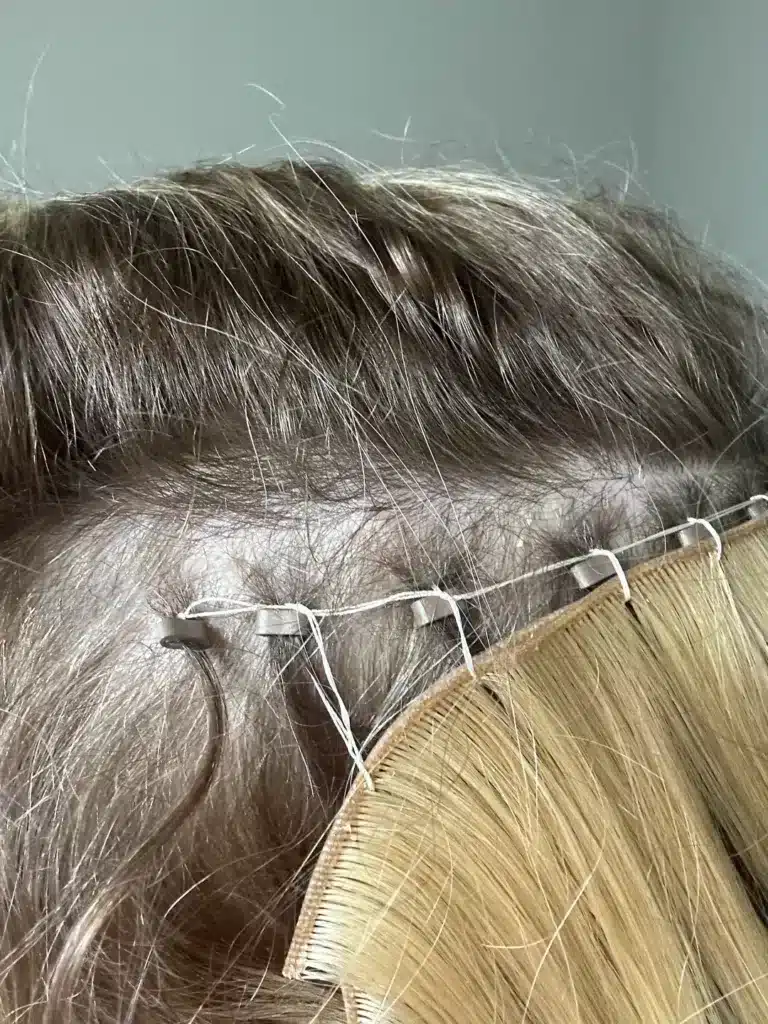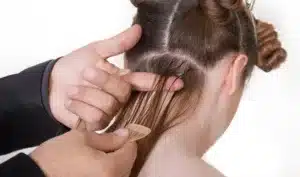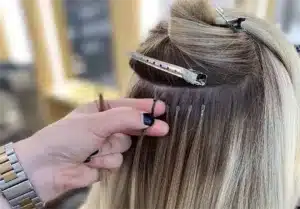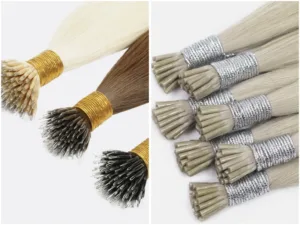Sewn In hair extensions are a premium investment—and how your clients sleep can make or break their longevity. If you’re a professional stylist, salon owner, or hair extension educator, this guide gives U the exact steps to protect your installs overnight and avoid early damage.
Yes, clients can sleep with Sewn In extensions, but they must follow a nighttime routine: detangle with a soft brush, apply light moisture, secure the hair in a protective style, and sleep on silk or satin. Never sleep on wet hair—always dry it thoroughly to avoid mildew and tension damage.
Want to prevent matting, tension breakage, and early weft slippage? This article gives U a salon-approved step-by-step guide—and real advice you can pass on to every client with a sew-in.

Why Night Care for Sewn Ins Matters
Unlike natural hair, extensions don’t regenerate or self-heal. Once damaged, that’s it. And unlike clip-ins or temporary extensions, Sewn Ins are stitched directly into the natural hair, so any tension or damage impacts the scalp too. Proper night care protects your client’s natural hair, scalp health, and keeps your install looking salon-fresh.
What Happens If Clients Sleep Incorrectly
Clients who sleep with Sewn Ins without proper care often face:
- Matting at the roots and underneath
- Frizz and tangling across lengths
- Tension-induced breakage at the braid base
- Premature loosening or shifting of the wefts
- Itchy, irritated scalp from product buildup and friction
The good news? Most of this can be avoided with just 5-10 minutes of prep each night.

How to Sleep With Sewn In Hair Extensions: Step-by-Step
1. Brush and Detangle Thoroughly
Before bed, gently detangle the hair using a loop brush, boar bristle brush, or wide-tooth comb. Start from the ends and work upward. This minimizes root tension and helps prevent matting. Brushing daily also helps redistribute natural oils from your client’s scalp down the hair shaft.
2. Moisturize Lightly
Sewn In hair doesn’t get nourishment from the scalp, so apply a lightweight leave-in conditioner or serum to the mid-lengths and ends. Avoid heavy oils or greasy products that can clog pores or cause buildup at the weft line.
3. Choose the Right Protective Style
Avoid going to bed with hair loose. Recommend:
- A loose, low braid
- Two pigtail braids
- A pineapple bun (for curly styles)
- Wrapped style under a silk scarf
Tight ponytails or buns can pull at the wefts and cause breakage. Gentle, secure, and low tension is the goal.
4. Silk or Satin Is Non-Negotiable
Cotton pillowcases are the enemy. They strip moisture, create friction, and cause tangling. Recommend silk or satin pillowcases—or go all-in with a silk bonnet or scarf to protect all angles.
Bonus: Silk fabrics help maintain hydration and keep the style fresher for longer.
5. Only Sleep on Dry Hair
This is a non-negotiable. Damp hair = mildew risk, tension on wet braids, and scalp irritation. If clients must wash at night, they should blow dry thoroughly on a cool setting before sleeping.
6. Scalp Massage or Oil (Optional)
For clients with dry scalps, a light scalp oil can be applied before bed—but with caution. Avoid saturating the braids or stitch line, as too much oil can cause weft slippage. Recommend oils with antibacterial properties, like tea tree or rosemary diluted in carrier oils.

Why This Routine Pays Off
Proper sleep care isn’t just about preventing issues—it extends the life of the install. Well-maintained full cuticle Sewn In extensions can last 8 to 12 weeks with consistent care. Tangled, dry, or matted hair? That’s a redo waiting to happen.
| Sleep Habit | Result |
| Loose braid or wrap | Maintains style & prevents tension at the braid base |
| Silk pillowcase/bonnet | Reduces dryness, breakage, and frizz |
| Brushing nightly | Prevents matting & keeps extensions flowing |
| Sleeping with dry hair | Avoids mildew and loosening of the thread work |
| Using serums/oils | Enhances moisture and shine without heavy buildup |
What Stylists Should Tell Clients
- Include this guide in aftercare printouts
- Offer a bedtime care kit (bonnet, silk pillowcase, brush, serum)
- Educate during install appointments—visual demos help
- Reiterate: proper care protects the client’s own hair just as much as the extensions
Remember, your clients are not extension experts—you are. Position yourself as their go-to for every step, not just the install.

FAQ: How to Sleep With Sewn In Hair Extensions
Q1:Can you sleep with wet sew-ins?
A1:No. Moisture weakens thread tension and can cause mildew where the weft meets the scalp.
Q2:Is a silk pillowcase enough, or do I need a bonnet too?
A2:Both offer great protection. For heavy tossers, combining both gives extra coverage.
Q3:Can I pineapple my sew-in if it’s curly?
A3:Yes. Pineappling helps preserve curl patterns overnight. Use a soft scrunchie and wrap with a silk scarf.
Q4:How often should I moisturize my sew-in before bed?
A4:2–3 times a week is ideal for most textures. Daily moisturizing may be needed in dry climates or if exposed to heat tools often.
Q5:What brush is safest for Sewn In extensions?
A5:Loop brushes or boar bristle brushes are best. Avoid metal bristles or rough detanglers that tug on the wefts.
Q6:Can sleeping wrong ruin my sew-in?
A6:Yes. Friction, tension, and dryness from poor night care shorten the life of the install and can even cause scalp pain.
Q7:Are Sewn Ins more prone to matting at night?
A7:Yes, especially with curlier textures or if clients sweat at night. Braiding the hair and sleeping with breathable fabric like silk can reduce this.
Q8:Is re-tightening needed if I sleep wrong once?
A8:Maybe not right away—but repeated neglect accelerates the need for tightening and increases risk of damage.
Q9:How can I stop itching while I sleep?
A9:Itching usually comes from buildup or dryness. Suggest a light scalp oil 2–3 times a week and dry shampoo between washes.
Q10:What should I avoid putting on my sew-in before bed?
A10:Avoid heavy oils, butters, gels, or any product with alcohol or sulfates. These either dry out the hair or cause product buildup.
Q11:Can I use a humidifier at night?
A11:Yes, especially in dry climates. A humidifier can help keep both the natural and extension hair hydrated.

Final Thoughts: Long-Lasting Sew-Ins Start at Night
Don’t underestimate the power of a good night’s sleep—for your client and their hair. When Sewn In extensions are cared for properly overnight, they stay smoother, flatter, and healthier-looking for weeks on end.
Help your clients build habits that protect their investment—and showcase your skill every time they wake up frizz-free.
Want a printable version of this guide for client use? Or need branded sleep care kits for your salon? Let us know—we’re here to support your artistry.




